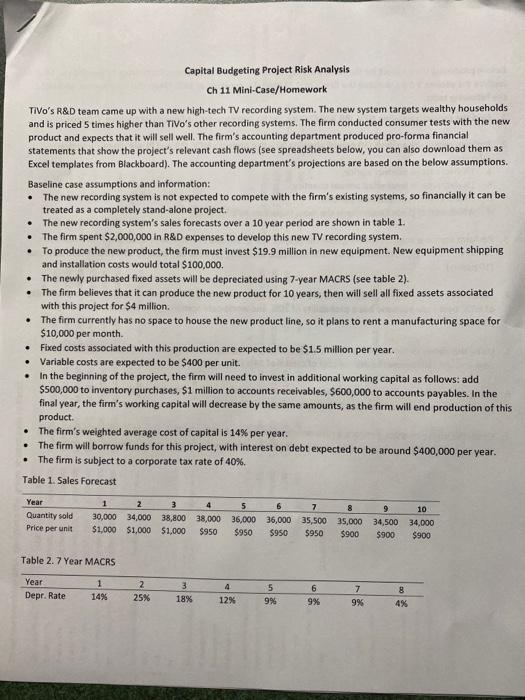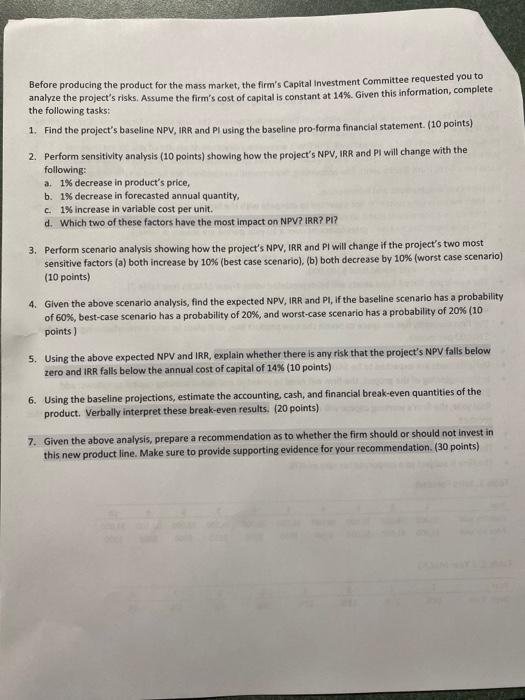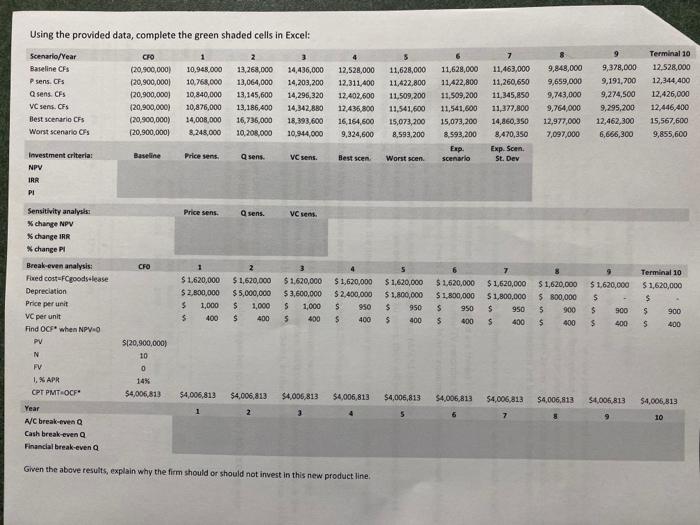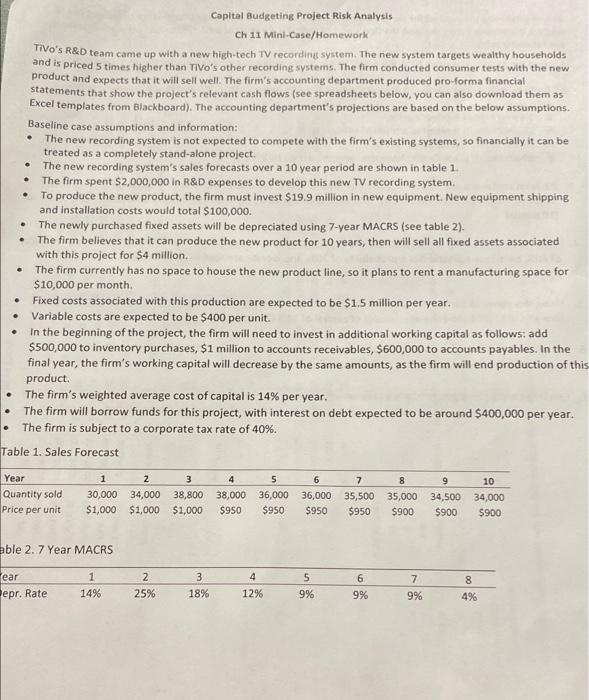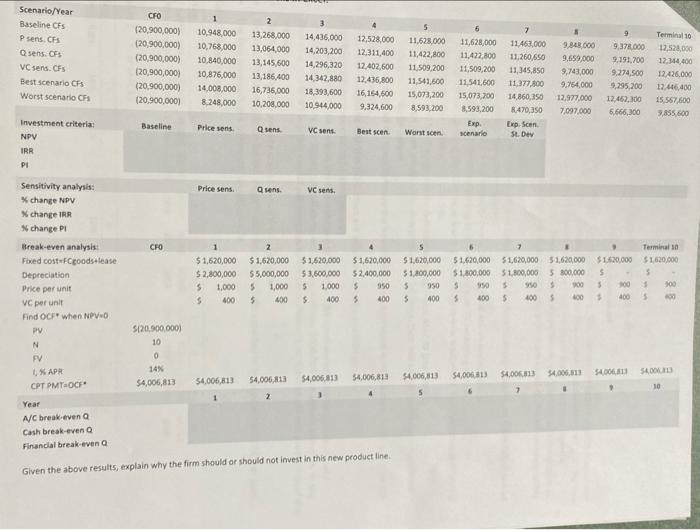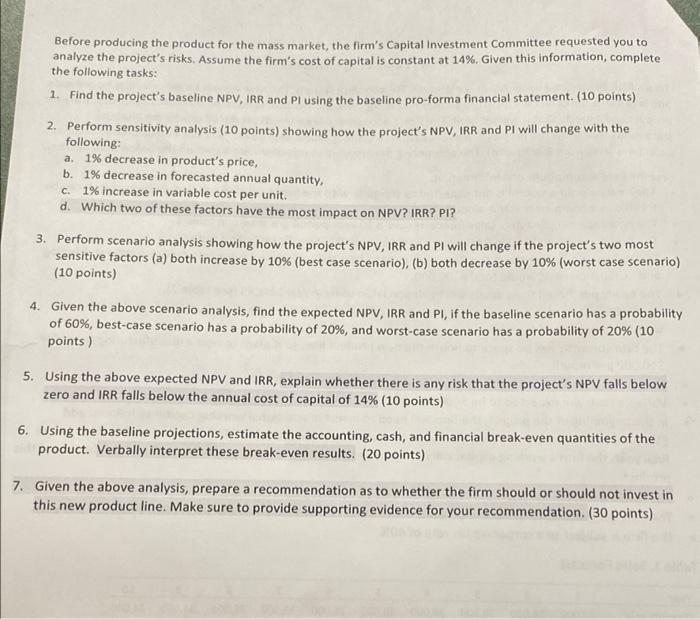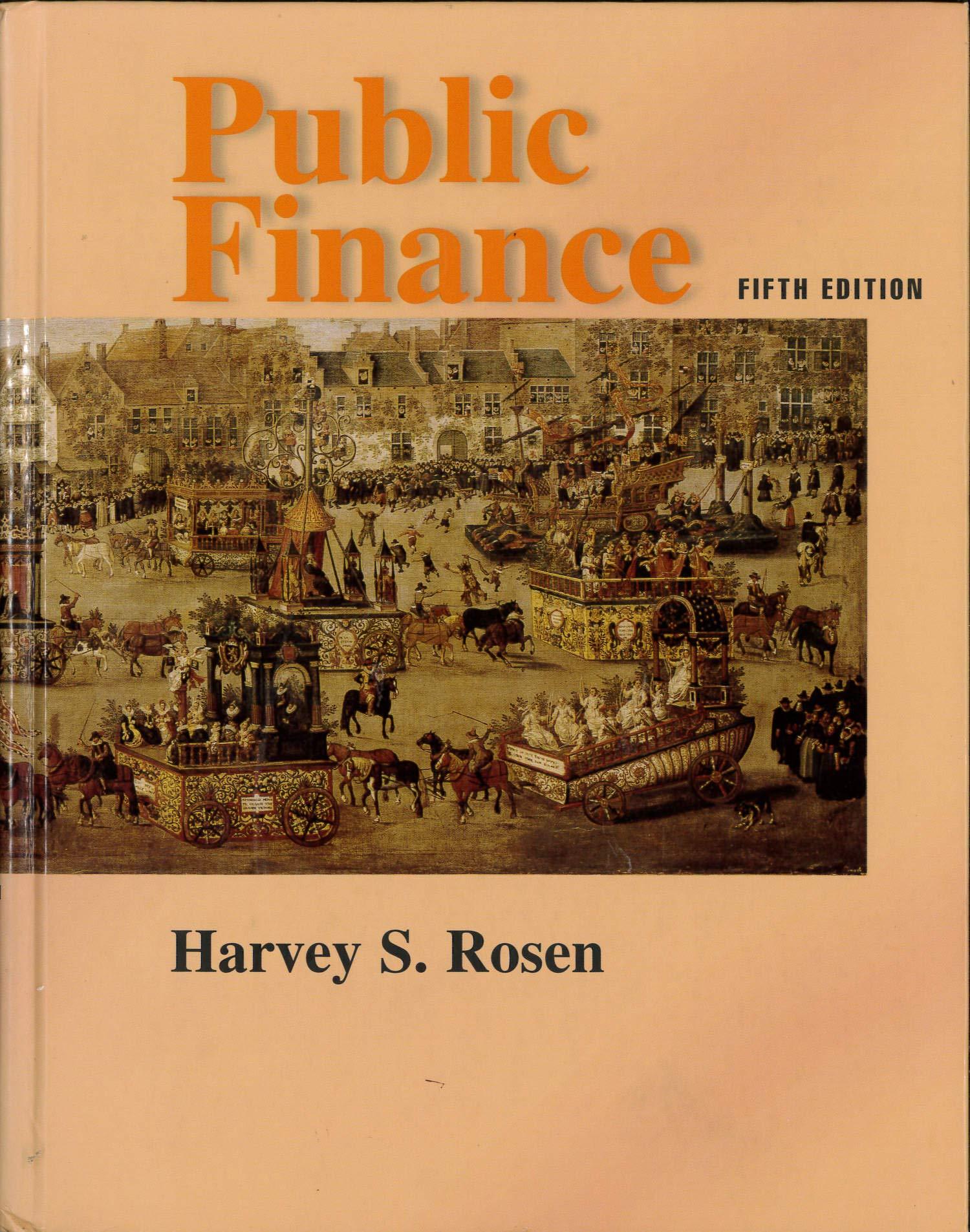. . . Capital Budgeting Project Risk Analysis Ch 11 Mini-Case/Homework TiVo's R&D team came up with a new high-tech TV recording system. The new system targets wealthy households and is priced 5 times higher than TiVo's other recording systems. The firm conducted consumer tests with the new product and expects that it will sell well. The firm's accounting department produced pro-forma financial statements that show the project's relevant cash flows (see spreadsheets below, you can also download them as Excel templates from Blackboard). The accounting department's projections are based on the below assumptions. Baseline case assumptions and information: The new recording system is not expected to compete with the firm's existing systems, so financially it can be treated as a completely stand-alone project. The new recording system's sales forecasts over a 10 year period are shown in table 1. The firm spent $2,000,000 in R&D expenses to develop this new TV recording system. To produce the new product, the firm must invest $19.9 million in new equipment. New equipment shipping and installation costs would total $100,000. The newly purchased fixed assets will be depreciated using 7-year MACRS (see table 2). The firm believes that it can produce the new product for 10 years, then will sell all fixed assets associated with this project for $4 million The firm currently has no space to house the new product line, so it plans to rent a manufacturing space for $10,000 per month Fixed costs associated with this production are expected to be $1.5 million per year. Variable costs are expected to be $400 per unit. . In the beginning of the project, the firm will need to invest in additional working capital as follows: add $500,000 to inventory purchases, $1 million to accounts receivables, $600,000 to accounts payables. In the final year, the firm's working capital will decrease by the same amounts, as the firm will end production of this product. The firm's weighted average cost of capital is 14% per year. The firm will borrow funds for this project, with interest on debt expected to be around $400,000 per year. The firm is subject to a corporate tax rate of 40% Table 1. Sales Forecast Year Quantity sold Price per unit 1 2 3 4 5 30,000 34,000 38,800 38,000 36,000 $1,000 $1,000 $1,000 $950 $950 6 7 8 9 10 36,000 35,500 35,000 34,500 34,000 $950 $950 $900 $900 $900 Table 2.7 Year MACRS Year Depr. Rate 1 14% 2 25% 3 18% 4 12% 5 9% 6 9% 9 7 9% % 8 4% Before producing the product for the mass market, the firm's Capital Investment Committee requested you to analyze the project's risks. Assume the firm's cost of capital is constant at 14%. Given this information, complete the following tasks: 1. Find the project's baseline NPV, IRR and Pl using the baseline pro-forma financial statement. (10 points) 2. Perform sensitivity analysis (10 points) showing how the project's NPV, IRR and Pl will change with the following: a. 1% decrease in product's price, b. 1% decrease in forecasted annual quantity, c. 1% increase in variable cost per unit. d. Which two of these factors have the most impact on NPV? IRR? PI? 3. Perform scenario analysis showing how the project's NPV, IRR and Pl will change if the project's two most sensitive factors (a) both increase by 10% (best case scenario). (b) both decrease by 10% (worst case scenario) (10 points) 4. Given the above scenario analysis, find the expected NPV, IRR and Pi, if the baseline scenario has a probability of 60%, best-case scenario has a probability of 20%, and worst-case scenario has a probability of 20% (10 points) 5. Using the above expected NPV and IRR, explain whether there is any risk that the project's NPV falls below zero and IRR falls below the annual cost of capital of 14% (10 points) 6. Using the baseline projections, estimate the accounting, cash, and financial break-even quantities of the product. Verbally interpret these break-even results. (20 points) 7. Given the above analysis, prepare a recommendation as to whether the firm should or should not invest in this new product line. Make sure to provide supporting evidence for your recommendation. (30 points) Using the provided data, complete the green shaded cells in Excel: CFO Scenario/Year Baseline CFS P sens. CFS Q sens. CFS VC sens. CFS Best scenarios Worst scenario CFS (20,900,000) (20,900,000 120,900,000 (20,900,000) (20,900,000) (20,900,000 10,948.000 10,768,000 10,840,000 20,876,000 14,000,000 8,248,000 13,268,000 13,064,000 13,145,600 13,186,400 16,736,000 10.208,000 14,436,000 14,203,200 14,296,320 14,342,880 18.393.600 10,944.000 12,528,000 12.311,400 12,402,600 12,436,800 16,154,600 9,324,600 11,628,000 11,422,800 11,509,200 11,541,600 15,073,200 8,593,200 11,628,000 11,422,800 11,509,200 11,541,600 15,073,200 8,593,200 Exp scenario 11,463,000 11,260,650 11,345,850 11,377,800 14,860,350 8,470,350 Exp. Scen. St. Dev 9,848,000 9,659,000 9,743,000 9,764,000 12,977,000 7,097,000 9,378,000 9,191,700 9,274,500 9,295,200 12,462,300 6,666,300 Terminal 10 12.528.000 12,344,400 12,426,000 12.446,400 15,567,600 9,855,600 Investment criteria: Baseline Price sens q sens. VC sens Best scen Worst scen. NPV IRR PI Price sens. asens. VC sens. CFO 1 Sensitivity analysis Xchange NPV change RR Xchange Pl Break-even analysis: Feed costofcgoods lease Depreciation Price per unit VC per unit Find OCF when NPVO PV $ 1.620,000 $ 2,800,000 $ 1,000 s 400 $1,620,000 $5,000,000 $ 1,000 $ 400 $1,620,000 $3,600,000 $ 1,000 5 400 $1,620,000 $ 2,400,000 S 950 $ 400 $ 1,620,000 $1,800,000 $ 950 $ 400 $1,620,000 $ 1.800,000 $ 950 $ 400 $1,620,000 S 1,800,000 $ 950 S 400 $1,620,000 5 800,000 5 900 $ 400 $ 1.620,000 $ $ $ 400 Terminal 10 $1,620,000 $ $ 900 5 400 900 $120,900,000) 10 N PV 0 1, % APR CPT PMT OCF 14% $4,006,813 $4,006,813 $4,006,813 $4.006,813 $4,006,813 $4,006,813 $4,006,813 $4,006,813 $4,006,813 $4.006.813 $4,006,813 1 2 10 Year A/C break-even Cash break-even Financial break-even Given the above results, explain why the firm should or should not invest in this new product line. a Capital Budgeting Project Risk Analysis Ch 11 Mini-Case/Homework TIVO's R&D team came up with a new high-tech TV recording system. The new system targets wealthy households and is priced 5 times higher than Tivo's other recording systems. The firm conducted consumer tests with the new product and expects that it will sell well. The firm's accounting department produced pro-forma financial statements that show the project's relevant cash flows (see spreadsheets below, you can also download them as Excel templates from Blackboard). The accounting department's projections are based on the below assumptions. Baseline case assumptions and information: The new recording system is not expected to compete with the firm's existing systems, so financially it can be treated as a completely stand-alone project. The new recording system's sales forecasts over a 10 year period are shown in table 1. The firm spent $2,000,000 in R&D expenses to develop this new TV recording system To produce the new product, the firm must invest $19.9 million in new equipment. New equipment shipping and installation costs would total $100,000 The newly purchased fixed assets will be depreciated using 7-year MACRS (see table 2). The firm believes that it can produce the new product for 10 years, then will sell all fixed assets associated with this project for $4 million The firm currently has no space to house the new product line, so it plans to rent a manufacturing space for $10,000 per month Fixed costs associated with this production are expected to be $1.5 million per year. Variable costs are expected to be $400 per unit. In the beginning of the project, the firm will need to invest in additional working capital as follows, add $500,000 to inventory purchases, $1 million to accounts receivables, $600,000 to accounts payables. In the final year, the firm's working capital will decrease by the same amounts, as the firm will end production of this product The firm's weighted average cost of capital is 14% per year, The firm will borrow funds for this project, with interest on debt expected to be around $400,000 per year. The firm is subject to a corporate tax rate of 40%. Table 1. Sales Forecast . 9 Year Quantity sold Price per unit 1 2 3 4 5 6 7 8 30,000 34,000 38,800 38,000 36,000 36,000 35,500 35,000 $1,000 $1,000 $1,000 $950 $950 $950 $950 $900 34,500 $900 10 34,000 $900 able 2.7 Year MACRS 7 Tear epr. Rate 1 14% 2 25% 3 18% 4 12% 5 9% 6 9% 8 4% 9% Scenario/Year Baseline Fs P sens.CH sens. O VC sens. CFS Best scenario C Worst scenario CFO (20,900,000) (20,900,000) (20,900,000) (20,900,000) (20,900,000) (20,900,000 10,948,000 10,768,000 10,840,000 10,876,000 14,000,000 8.248.000 2 13,268,000 13,064,000 13,145 600 13,186.400 16,736,000 10,208,000 14,436,000 14,203,200 14,296,320 14,342,880 18,393,600 10.944,000 12,528.000 12,311,400 12.402,600 12,436,800 16,164,500 9,324,600 11,628.000 11.422,800 11 509 200 11.543,500 15,073,200 8.593,200 11,628,000 11,422,800 11,509,200 11.541.600 15,073,700 8.593,200 Exp scenario 11.463,000 11,260,650 11,345,850 11,377,800 14,860,350 470,350 Exp. Sen St. De 9.348.000 9,659,000 9,743,000 9.764,000 12,977.000 7,097.000 9 9.371.000 9,191.700 9,274,500 9,295,200 12,462,300 6.666,300 Terminal 10 12,528,000 12,144.400 12426,000 12/446,400 15,557,600 9,855,600 Baseline Price sens Q sens. VC sens Best scen Worst soen Investment criteria: NPV IRR PI Price sens Q sens VC sens CFO $1,620,000 $ 2.800,000 $ 1,000 5 400 $1,620,000 55,000,000 5 1,000 5 400 $ 1.620.000 $3,600,000 5 1,000 S 400 $1,620,000 $ 2,400,000 5 5 400 $ 1.620,000 $ 1.800,000 5. 950 $ 400 51.620,000 51.620,000 $1,000,000 $1,800,000 5 950 5 950 5 100 5 100 $1,620,000 5 800.000 5 00 400 $1.620.000 5 3 100 100 Terminal $1,620,000 3 1 100 5 90 950 Sensitivity analysis: Xchange NPV xchange RR change Pl Break-even analysis Fixed cost Foods lease Depreciation Price per unit V per unit Find OCT when NPVO PY N FV L CPT PMT OF Year A/C break-even Cash break-even Financial break even a $120.000.000) 10 0 14% 54,006,813 $4.006.813 54.00 54,006,813 54.006.13 54.006,813 54,006.13 54.00613 $4.006.813 54,006,810 54,00 10 2 3 Given the above results, explain why the firm should or should not invest in this new product line Before producing the product for the mass market, the firm's Capital Investment Committee requested you to analyze the project's risks. Assume the firm's cost of capital is constant at 14%. Given this information, complete the following tasks: 1. Find the project's baseline NPV, IRR and Pl using the baseline pro-forma financial statement. (10 points) 2. Perform sensitivity analysis (10 points) showing how the project's NPV, IRR and Pl will change with the following: a. 1% decrease in product's price, b. 1% decrease in forecasted annual quantity, c. 1% increase in variable cost per unit. d. Which two of these factors have the most impact on NPV? IRR? PI? 3. Perform scenario analysis showing how the project's NPV, IRR and Pl will change if the project's two most sensitive factors (a) both increase by 10% (best case scenario), (b) both decrease by 10% (worst case scenario) (10 points) 4. Given the above scenario analysis, find the expected NPV, IRR and Pl, if the baseline scenario has a probability of 60%, best-case scenario has a probability of 20%, and worst-case scenario has a probability of 20% (10 points) 5. Using the above expected NPV and IRR, explain whether there is any risk that the project's NPV falls below zero and IRR falls below the annual cost of capital of 14% (10 points) 6. Using the baseline projections, estimate the accounting, cash, and financial break-even quantities of the product. Verbally interpret these break-even results. (20 points) 7. Given the above analysis, prepare a recommendation as to whether the firm should or should not invest in this new product line. Make sure to provide supporting evidence for your recommendation (30 points) . . . Capital Budgeting Project Risk Analysis Ch 11 Mini-Case/Homework TiVo's R&D team came up with a new high-tech TV recording system. The new system targets wealthy households and is priced 5 times higher than TiVo's other recording systems. The firm conducted consumer tests with the new product and expects that it will sell well. The firm's accounting department produced pro-forma financial statements that show the project's relevant cash flows (see spreadsheets below, you can also download them as Excel templates from Blackboard). The accounting department's projections are based on the below assumptions. Baseline case assumptions and information: The new recording system is not expected to compete with the firm's existing systems, so financially it can be treated as a completely stand-alone project. The new recording system's sales forecasts over a 10 year period are shown in table 1. The firm spent $2,000,000 in R&D expenses to develop this new TV recording system. To produce the new product, the firm must invest $19.9 million in new equipment. New equipment shipping and installation costs would total $100,000. The newly purchased fixed assets will be depreciated using 7-year MACRS (see table 2). The firm believes that it can produce the new product for 10 years, then will sell all fixed assets associated with this project for $4 million The firm currently has no space to house the new product line, so it plans to rent a manufacturing space for $10,000 per month Fixed costs associated with this production are expected to be $1.5 million per year. Variable costs are expected to be $400 per unit. . In the beginning of the project, the firm will need to invest in additional working capital as follows: add $500,000 to inventory purchases, $1 million to accounts receivables, $600,000 to accounts payables. In the final year, the firm's working capital will decrease by the same amounts, as the firm will end production of this product. The firm's weighted average cost of capital is 14% per year. The firm will borrow funds for this project, with interest on debt expected to be around $400,000 per year. The firm is subject to a corporate tax rate of 40% Table 1. Sales Forecast Year Quantity sold Price per unit 1 2 3 4 5 30,000 34,000 38,800 38,000 36,000 $1,000 $1,000 $1,000 $950 $950 6 7 8 9 10 36,000 35,500 35,000 34,500 34,000 $950 $950 $900 $900 $900 Table 2.7 Year MACRS Year Depr. Rate 1 14% 2 25% 3 18% 4 12% 5 9% 6 9% 9 7 9% % 8 4% Before producing the product for the mass market, the firm's Capital Investment Committee requested you to analyze the project's risks. Assume the firm's cost of capital is constant at 14%. Given this information, complete the following tasks: 1. Find the project's baseline NPV, IRR and Pl using the baseline pro-forma financial statement. (10 points) 2. Perform sensitivity analysis (10 points) showing how the project's NPV, IRR and Pl will change with the following: a. 1% decrease in product's price, b. 1% decrease in forecasted annual quantity, c. 1% increase in variable cost per unit. d. Which two of these factors have the most impact on NPV? IRR? PI? 3. Perform scenario analysis showing how the project's NPV, IRR and Pl will change if the project's two most sensitive factors (a) both increase by 10% (best case scenario). (b) both decrease by 10% (worst case scenario) (10 points) 4. Given the above scenario analysis, find the expected NPV, IRR and Pi, if the baseline scenario has a probability of 60%, best-case scenario has a probability of 20%, and worst-case scenario has a probability of 20% (10 points) 5. Using the above expected NPV and IRR, explain whether there is any risk that the project's NPV falls below zero and IRR falls below the annual cost of capital of 14% (10 points) 6. Using the baseline projections, estimate the accounting, cash, and financial break-even quantities of the product. Verbally interpret these break-even results. (20 points) 7. Given the above analysis, prepare a recommendation as to whether the firm should or should not invest in this new product line. Make sure to provide supporting evidence for your recommendation. (30 points) Using the provided data, complete the green shaded cells in Excel: CFO Scenario/Year Baseline CFS P sens. CFS Q sens. CFS VC sens. CFS Best scenarios Worst scenario CFS (20,900,000) (20,900,000 120,900,000 (20,900,000) (20,900,000) (20,900,000 10,948.000 10,768,000 10,840,000 20,876,000 14,000,000 8,248,000 13,268,000 13,064,000 13,145,600 13,186,400 16,736,000 10.208,000 14,436,000 14,203,200 14,296,320 14,342,880 18.393.600 10,944.000 12,528,000 12.311,400 12,402,600 12,436,800 16,154,600 9,324,600 11,628,000 11,422,800 11,509,200 11,541,600 15,073,200 8,593,200 11,628,000 11,422,800 11,509,200 11,541,600 15,073,200 8,593,200 Exp scenario 11,463,000 11,260,650 11,345,850 11,377,800 14,860,350 8,470,350 Exp. Scen. St. Dev 9,848,000 9,659,000 9,743,000 9,764,000 12,977,000 7,097,000 9,378,000 9,191,700 9,274,500 9,295,200 12,462,300 6,666,300 Terminal 10 12.528.000 12,344,400 12,426,000 12.446,400 15,567,600 9,855,600 Investment criteria: Baseline Price sens q sens. VC sens Best scen Worst scen. NPV IRR PI Price sens. asens. VC sens. CFO 1 Sensitivity analysis Xchange NPV change RR Xchange Pl Break-even analysis: Feed costofcgoods lease Depreciation Price per unit VC per unit Find OCF when NPVO PV $ 1.620,000 $ 2,800,000 $ 1,000 s 400 $1,620,000 $5,000,000 $ 1,000 $ 400 $1,620,000 $3,600,000 $ 1,000 5 400 $1,620,000 $ 2,400,000 S 950 $ 400 $ 1,620,000 $1,800,000 $ 950 $ 400 $1,620,000 $ 1.800,000 $ 950 $ 400 $1,620,000 S 1,800,000 $ 950 S 400 $1,620,000 5 800,000 5 900 $ 400 $ 1.620,000 $ $ $ 400 Terminal 10 $1,620,000 $ $ 900 5 400 900 $120,900,000) 10 N PV 0 1, % APR CPT PMT OCF 14% $4,006,813 $4,006,813 $4,006,813 $4.006,813 $4,006,813 $4,006,813 $4,006,813 $4,006,813 $4,006,813 $4.006.813 $4,006,813 1 2 10 Year A/C break-even Cash break-even Financial break-even Given the above results, explain why the firm should or should not invest in this new product line. a Capital Budgeting Project Risk Analysis Ch 11 Mini-Case/Homework TIVO's R&D team came up with a new high-tech TV recording system. The new system targets wealthy households and is priced 5 times higher than Tivo's other recording systems. The firm conducted consumer tests with the new product and expects that it will sell well. The firm's accounting department produced pro-forma financial statements that show the project's relevant cash flows (see spreadsheets below, you can also download them as Excel templates from Blackboard). The accounting department's projections are based on the below assumptions. Baseline case assumptions and information: The new recording system is not expected to compete with the firm's existing systems, so financially it can be treated as a completely stand-alone project. The new recording system's sales forecasts over a 10 year period are shown in table 1. The firm spent $2,000,000 in R&D expenses to develop this new TV recording system To produce the new product, the firm must invest $19.9 million in new equipment. New equipment shipping and installation costs would total $100,000 The newly purchased fixed assets will be depreciated using 7-year MACRS (see table 2). The firm believes that it can produce the new product for 10 years, then will sell all fixed assets associated with this project for $4 million The firm currently has no space to house the new product line, so it plans to rent a manufacturing space for $10,000 per month Fixed costs associated with this production are expected to be $1.5 million per year. Variable costs are expected to be $400 per unit. In the beginning of the project, the firm will need to invest in additional working capital as follows, add $500,000 to inventory purchases, $1 million to accounts receivables, $600,000 to accounts payables. In the final year, the firm's working capital will decrease by the same amounts, as the firm will end production of this product The firm's weighted average cost of capital is 14% per year, The firm will borrow funds for this project, with interest on debt expected to be around $400,000 per year. The firm is subject to a corporate tax rate of 40%. Table 1. Sales Forecast . 9 Year Quantity sold Price per unit 1 2 3 4 5 6 7 8 30,000 34,000 38,800 38,000 36,000 36,000 35,500 35,000 $1,000 $1,000 $1,000 $950 $950 $950 $950 $900 34,500 $900 10 34,000 $900 able 2.7 Year MACRS 7 Tear epr. Rate 1 14% 2 25% 3 18% 4 12% 5 9% 6 9% 8 4% 9% Scenario/Year Baseline Fs P sens.CH sens. O VC sens. CFS Best scenario C Worst scenario CFO (20,900,000) (20,900,000) (20,900,000) (20,900,000) (20,900,000) (20,900,000 10,948,000 10,768,000 10,840,000 10,876,000 14,000,000 8.248.000 2 13,268,000 13,064,000 13,145 600 13,186.400 16,736,000 10,208,000 14,436,000 14,203,200 14,296,320 14,342,880 18,393,600 10.944,000 12,528.000 12,311,400 12.402,600 12,436,800 16,164,500 9,324,600 11,628.000 11.422,800 11 509 200 11.543,500 15,073,200 8.593,200 11,628,000 11,422,800 11,509,200 11.541.600 15,073,700 8.593,200 Exp scenario 11.463,000 11,260,650 11,345,850 11,377,800 14,860,350 470,350 Exp. Sen St. De 9.348.000 9,659,000 9,743,000 9.764,000 12,977.000 7,097.000 9 9.371.000 9,191.700 9,274,500 9,295,200 12,462,300 6.666,300 Terminal 10 12,528,000 12,144.400 12426,000 12/446,400 15,557,600 9,855,600 Baseline Price sens Q sens. VC sens Best scen Worst soen Investment criteria: NPV IRR PI Price sens Q sens VC sens CFO $1,620,000 $ 2.800,000 $ 1,000 5 400 $1,620,000 55,000,000 5 1,000 5 400 $ 1.620.000 $3,600,000 5 1,000 S 400 $1,620,000 $ 2,400,000 5 5 400 $ 1.620,000 $ 1.800,000 5. 950 $ 400 51.620,000 51.620,000 $1,000,000 $1,800,000 5 950 5 950 5 100 5 100 $1,620,000 5 800.000 5 00 400 $1.620.000 5 3 100 100 Terminal $1,620,000 3 1 100 5 90 950 Sensitivity analysis: Xchange NPV xchange RR change Pl Break-even analysis Fixed cost Foods lease Depreciation Price per unit V per unit Find OCT when NPVO PY N FV L CPT PMT OF Year A/C break-even Cash break-even Financial break even a $120.000.000) 10 0 14% 54,006,813 $4.006.813 54.00 54,006,813 54.006.13 54.006,813 54,006.13 54.00613 $4.006.813 54,006,810 54,00 10 2 3 Given the above results, explain why the firm should or should not invest in this new product line Before producing the product for the mass market, the firm's Capital Investment Committee requested you to analyze the project's risks. Assume the firm's cost of capital is constant at 14%. Given this information, complete the following tasks: 1. Find the project's baseline NPV, IRR and Pl using the baseline pro-forma financial statement. (10 points) 2. Perform sensitivity analysis (10 points) showing how the project's NPV, IRR and Pl will change with the following: a. 1% decrease in product's price, b. 1% decrease in forecasted annual quantity, c. 1% increase in variable cost per unit. d. Which two of these factors have the most impact on NPV? IRR? PI? 3. Perform scenario analysis showing how the project's NPV, IRR and Pl will change if the project's two most sensitive factors (a) both increase by 10% (best case scenario), (b) both decrease by 10% (worst case scenario) (10 points) 4. Given the above scenario analysis, find the expected NPV, IRR and Pl, if the baseline scenario has a probability of 60%, best-case scenario has a probability of 20%, and worst-case scenario has a probability of 20% (10 points) 5. Using the above expected NPV and IRR, explain whether there is any risk that the project's NPV falls below zero and IRR falls below the annual cost of capital of 14% (10 points) 6. Using the baseline projections, estimate the accounting, cash, and financial break-even quantities of the product. Verbally interpret these break-even results. (20 points) 7. Given the above analysis, prepare a recommendation as to whether the firm should or should not invest in this new product line. Make sure to provide supporting evidence for your recommendation (30 points)
